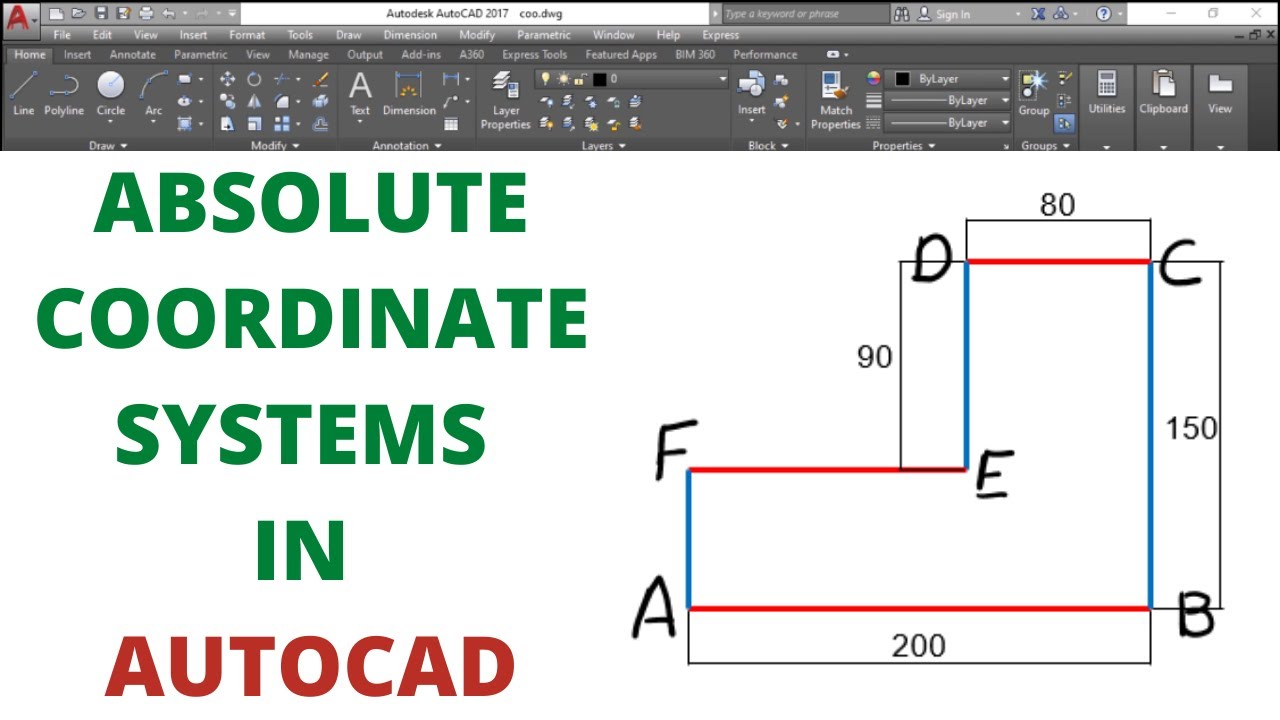
Introduction:
In the intricate world of Computer-Aided Design (CAD), AutoCAD stands as a pioneering software, providing a multitude of tools to architects, engineers, and designers. Among the foundational concepts that underpin precision and accuracy in AutoCAD is the use of absolute coordinates. This extensive guide aims to delve into the intricacies of AutoCAD absolute coordinates, exploring their functionalities, applications, and the profound impact they have on the drafting process.
Section 1: Unraveling AutoCAD Absolute Coordinates
1.1 Defining Absolute Coordinates: Absolute coordinates in AutoCAD represent a fixed position within a drawing, defined by specific X, Y, and Z values on the Cartesian coordinate system. Unlike relative coordinates, which are referenced from a specific point, absolute coordinates provide an unambiguous and constant reference point within the drawing space.
1.2 Cartesian Coordinate System: Explore the Cartesian coordinate system within AutoCAD, where absolute coordinates are rooted. Understand the significance of the X-axis, Y-axis, and Z-axis as they intersect at the origin (0,0,0), serving as the reference point for absolute coordinates.
Section 2: Syntax and Usage of Absolute Coordinates
2.1 Absolute Coordinate Syntax: Delve into the syntax used to input absolute coordinates in AutoCAD. Understand the numerical values representing distances along the X, Y, and Z axes and the importance of commas or spaces to separate these values.
2.2 Absolute Coordinates in 2D and 3D: Explore the application of absolute coordinates in both 2D and 3D drafting environments. Understand how the use of absolute coordinates transcends dimensions, providing consistency and precision across different planes.
Section 3: Basic Operations Using Absolute Coordinates
3.1 Creating Objects: Learn how to use absolute coordinates to create objects in AutoCAD. Understand the process of specifying precise points in space to draw lines, circles, polygons, and other geometric shapes with accuracy.
3.2 Editing Objects: Explore how absolute coordinates facilitate the editing of existing objects. From moving and copying to rotating and scaling, understand how absolute coordinates provide a precise means of manipulating design elements.
Section 4: Dynamic Input and Absolute Coordinates
4.1 Dynamic Input Features: Understand how AutoCAD’s dynamic input feature complements the use of absolute coordinates. Learn how real-time feedback and input options enhance the precision and speed of drafting tasks.
4.2 Configuring Dynamic Input for Absolute Coordinates: Navigate through the settings to configure dynamic input for optimal use with absolute coordinates. Explore customization options to tailor the dynamic input to individual preferences and project requirements.
Section 5: Advanced Techniques and Tips
5.1 Keyboard Shortcuts for Absolute Coordinates: Master essential keyboard shortcuts for inputting absolute coordinates quickly and efficiently. Explore time-saving techniques that enhance your productivity in AutoCAD.
5.2 Relative vs. Absolute Coordinates: Delve into the comparative analysis of relative and absolute coordinates within AutoCAD. Understand the advantages of each system and when to choose absolute coordinates for maximum precision.
Section 6: Challenges and Troubleshooting
6.1 Common Mistakes with Absolute Coordinates: Address common pitfalls and mistakes users may encounter when working with absolute coordinates. From input errors to coordinate system shifts, gain insights into effective problem-solving strategies.
6.2 Troubleshooting Tips: Explore troubleshooting tips for resolving issues related to absolute coordinates. From unexpected results to unintended movements, understand how to maintain control and precision in your drawings.
Section 7: Absolute Coordinates in Specialized Applications
7.1 Absolute Coordinates in Civil 3D and MEP: Explore the integration of absolute coordinates in specialized AutoCAD environments such as Civil 3D and MEP. Understand how this feature enhances the precision of designing civil infrastructure and building systems.
7.2 Absolute Coordinates in GIS and Surveying: Discover the significance of absolute coordinates in GIS and surveying applications within AutoCAD. Explore how precise spatial referencing is crucial for accurate mapping and data analysis.
Conclusion:
As we conclude this comprehensive exploration of AutoCAD absolute coordinates, it becomes evident that this feature is a cornerstone of precision and efficiency in the world of CAD. Whether you are a novice seeking to enhance your drafting skills or a seasoned professional navigating complex projects, mastering absolute coordinates unlocks a realm of possibilities. Embrace the accuracy, consistency, and versatility that absolute coordinates bring to your AutoCAD workflow, and witness how this fundamental feature transforms your designs from concepts to meticulously crafted drawings. With continuous practice and application, you will navigate the intricate landscape of drafting with confidence, producing drawings that stand as testaments to the power of precision in AutoCAD.